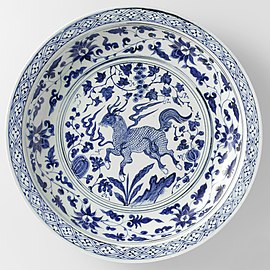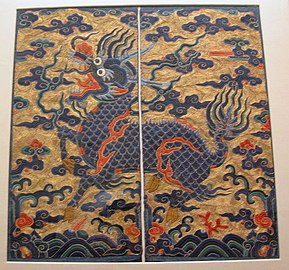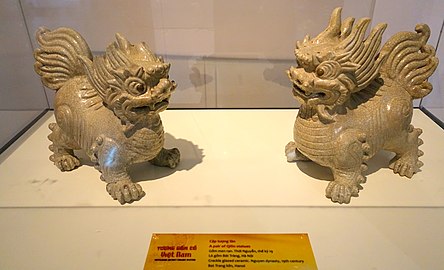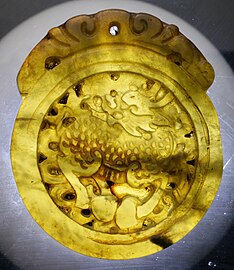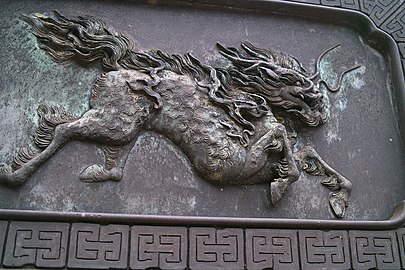Qilin
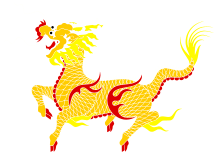 Qing era depiction of a qilin | |
| Grouping | Legendary creature |
|---|---|
| Sub grouping | Chimera |
| Similar entities | kirin, kỳ lân, gilen |
| First attested | 5th century BCE |
| Country | China |
| Qilin | ||
|---|---|---|
Hanyu Pinyin qílín | | |
| Wade–Giles | ch'i2-lin2 | |
| IPA | [tɕʰǐ.lǐn] | |
| Yue: Cantonese | ||
| Yale Romanization | kèih-lèuhn | |
| Jyutping | kei4-leon4 | |
| IPA | [kʰei˩.lɵn˧˥] | |
| Southern Min | ||
| Hokkien POJ | kî-lîn | |
| Transcriptions | |
|---|---|
| Revised Romanization | Girin |
| McCune–Reischauer | Kirin |
| Transcriptions | |
|---|---|
| Romanization | kirin |
The qilin (English: /tʃiˈlɪn/ chee-LIN; Chinese: 麒麟) is a legendary hooved chimerical creature that appears in Chinese mythology, and is said to appear with the imminent arrival or passing of a sage or illustrious ruler.[1] Qilin are a specific type of the lin mythological family of one-horned beasts. The qilin also appears in the mythologies of other Chinese-influenced cultures.
Origins

The earliest mention of the mythical qilin is in the poem 麟之趾; Lín zhī zhǐ; 'Feet of the Lin' included in the Classic of Poetry (11th – 7th c. BCE).[2][3] Spring and Autumn Annals mentioned that a lin (麟) was captured in the 14th year of Duke Ai of Lu (魯哀公) (481 CE); Zuo Zhuan credited Confucius with identifying the lin as such.[4][5][6]

The bisyllabic form qilin (麒麟 ~ 騏驎), which carries the same generic meaning as lin alone, is attested in works dated to the Warring States period (475 – 221 BCE).[7] Qi denotes the male and lin denotes the female[8] according to Shuowen Jiezi.[9][10]
The legendary image of the qilin became associated with the image of the
Axel Schuessler reconstructs
Description

Qilin generally have Chinese dragon-like features: similar heads with antlers, eyes with thick eyelashes, manes that always flow upward, and beards. The body is fully or partially scaled and often shaped like an ox, deer, or horse, or more commonly a goat.[19][20] They are always shown with cloven hooves.[21] While dragons in China (and thus qilin) are also most commonly depicted as golden, qilin may be of any color or even various colors, and can be depicted as bejeweled or exhibiting a jewel-like brilliance.[22]
The qilin is depicted throughout a wide range of Chinese art, sometimes with parts of their bodies on fire.[21]
Legends tell that qilin have appeared in the
Qilin as unicorns

In modern times, the depictions of qilin have often fused with the Western concept of unicorns. Qilin (麒麟) is often translated into English as "unicorn"; Shuowen Jiezi described qi as single-horned,[9] and it can sometimes be depicted as having a single horn. The translation, however, may be misleading, as qilin can also be depicted as having two horns. In modern Chinese, "one-horned beast" (独角兽; 獨角獸; Dújiǎoshòu) is used for "unicorns". A number of different Chinese mythical creatures can be depicted with a single horn, and a qilin depicted with one horn may be called a "one-horned qilin" in Chinese, not a "unicorn".[citation needed]


Nevertheless, the mythical and etymological connections between the creatures have been noted by various cultural studies[16][17][18] and even the Chinese government, which has minted silver, gold, and platinum commemorative coins depicting both archetypal creatures.[23]
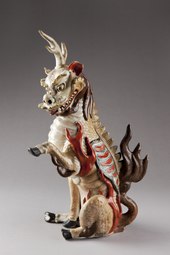
Other cultural representations
East Asia
Japan
Kirin, which has also come to be used as the modern Japanese word for a giraffe, are similar to qilin. Japanese art tends to depict the kirin as more deer-like than in Chinese art. Alternatively, it is depicted as a dragon shaped like a deer, but with an ox's tail[24] instead of a lion's tail. They are also often portrayed as partially unicorn-like in appearance, but with a backwards curving horn.
Korea
Girin or kirin (기린) is the Korean form of qilin. It is described as a maned creature with the torso of a deer, an ox tail with the hooves of a horse. The girin were initially depicted as more deer-like, however over time they have transformed into more horse-like.[25] They were one of the four divine creatures along with the dragon, phoenix, and turtle. Girin were extensively used in Korean royal and Buddhist arts.
In modern Korean, the term "girin" is used for "giraffe".
Southeast Asia
Thailand
In Thailand, the qilin is known as "gilen" (
In Phra Aphai Mani, the masterpiece epic poem of Sunthorn Phu, a renowned poet of the 18th century. There is a monster that is Sudsakorn's steed, one of the main characters in the epic. This creature was called "Ma Nin Mangkorn" (Thai: ม้านิลมังกร, "ceylonite dragon horse"), it is depicted as it has diamond fangs, ceylonite scales, and a birthmark on the tongue. It was a mixture of horse, dragon, deer antlers, fish scales, and Phaya Nak tail, with has black sequins all over. Its appearance resembles a qilin.[27]
Gallery
-
Qilin statue in Pingzhen Xinshi Park, Taoyuan, Taiwan
-
A Ming-era painting of a tribute giraffe, which was thought to be a qilin by court officials, from Bengal
-
Plate with a qilin in the center, Yuan dynasty
-
Embroidered qilin, Qing dynasty
-
Kỳ Lân statues, Bat Trang kiln, Hanoi,National Museum of Vietnamese Historyin Hanoi, Vietnam
-
The logo of Kirin Beer features a kirin (photo taken in Hiroshima, Japan)
-
Qilin pendant
-
Qilin incense burner at the World Museum in Liverpool, United Kingdom
-
Qilin incense burner (one of a pair) at the World Museum in Liverpool, United Kingdom
-
Qilin depicted in the Imperial Encyclopaedia
-
Kirin relief in Tokyo, Japan
-
A winged variant of kirin statue in Tokyo, Japan
-
Qilin (kî-lîn) as an object of worship in Yilan, Taiwan
See also
- Nian
- Chinthe
- Chimera
- Chinese dragon
- Chinese spiritual world concepts
- Fenghuang
- Four Holy Beasts
- Giraffe
- Japanese dragon
- Kanglasha
- Longma
- Nongshaba
- Pakhangba
- Pixiu
- Poubi Lai
- Questing Beast
- Serpopard
- Shaanxi Kylins
- Shisa
- Singha
- Sin-you
- Sudsakorn (involving a similar creature that aided the protagonist, known as Mar Nin Mang Korn)
- Taoroinai
- Unicorn
- Xiezhi
- Yali
References
- ^ a b "qilin (Chinese mythology)". Encyclopædia Britannica. Retrieved 24 July 2011.
- ^ Classic of Poetry "Airs of Zhou and the South – Lin's Feet" translated by James Legge
- ^ Durrant, Li, & Schaberg (translators) (2016). Zuo tradition: Commentary on the Spring and Autumn Annals. Seattle & London: University of Washington Press. p. 1920, n. 292. quote: "It is significant that the earliest source known to mention the lin itself is “Lin zhi zhi” 麟之趾, or “The Foot of the Lin"
- ^ 古建上的主要装饰纹样――麒麟 古建园林技术-作者:徐华铛 Archived 30 September 2007 at the Wayback Machine
- ^ Zuozhuan "Duke Ai – 14th year – jing & zhuan"'
- ^ Durrant, Li, & Schaberg (translators) (2016). Zuo tradition: Commentary on the Spring and Autumn Annals. pp. 1919–1921
- CGTN; quote: "The Four Auspicious Beasts [四灵; 四靈; sì líng: qilin, long, bixi, fenghuang.] are also said to be the rulers of all the other animals. The first known mention of them dates from the Warring States Period (475 BC-221 BC)." Cf. Book of Rites "Li Yun 23" quote: "麟鳳龜龍,謂之四靈。"
- ^ ChinaKnowledge.de
- ^ elaphure's body, ox's tail, and one horn. [...] Lín (麐): female qí."
- ^ Parker, Jeannie Thomas (2018) The Mythic Chinese unicorn. Victoria: Friesen Press. p. 44
- ^ 此“麟”非彼“麟”专家称萨摩麟并非传说中麒麟
- ^ 傳說中的聖獸—麒麟[permanent dead link]
- ISSN 1078-6279.
- ^ Wilson, Samuel M. (December 1992). "The Emperor's Giraffe". Natural History. Vol. 101, no. 12. pp. 22–25. Archived from the original on 2 December 2008. Retrieved 14 April 2012.
- ^ 傳世麒麟圖考察初稿 張之傑[permanent dead link]
- ^ a b Parker, J. T.:" The Mythic Chinese Unicorn"
- ^ a b Janhunen, J. (2011). Unicorn, Mammoth, Whale: mythological and etymological connections of zoonyms in North and East Asia. Linguistics, Archaeology and the Human Past, Occasional Paper, 12, 189–222.
- ^ a b "Хирс in Bolor dictionary". Archived from the original on 26 September 2022. Retrieved 31 January 2019.
- ^ "Charger with a qilin, anonymous, c. 1350". Rijksmuseum. Retrieved 15 May 2022.
- ^ ISBN 9780824872564.
- ^ ISBN 9780824872564.
- S2CID 192217718– via JSTOR.
- ^ "5 Yuan, China". en.numista.com. Numista. Retrieved 13 December 2017.
- ISBN 978-1-4264-9918-0.
- ^ 기린 : 네이버캐스트
- ^ "Taep Payatorn Riding Qilin Himapant Lion Hlang Yant – Nuea Pong Maha Sanaeh Luan – Ajarn Warut – Wat Pong Wonaram". Buddha Magic Multimedia & Publications. Retrieved 12 January 2016.
- ^ Pralongchoeng, Gilen (20 September 2014). "ม้ามังกร" [Dragon horse]. Thai Rath (in Thai). Retrieved 7 August 2021.
External links
 Media related to Qilin at Wikimedia Commons
Media related to Qilin at Wikimedia Commons



